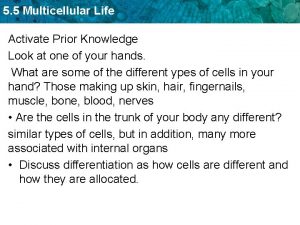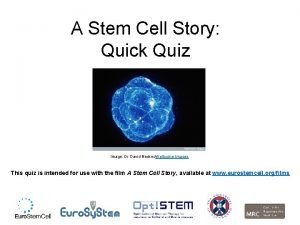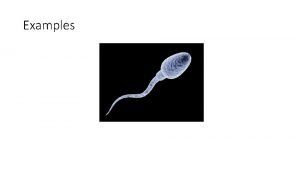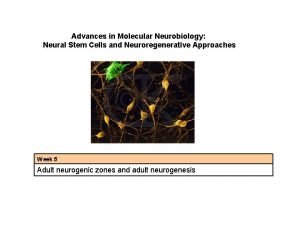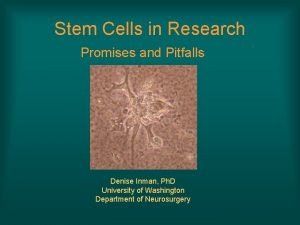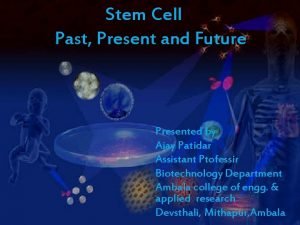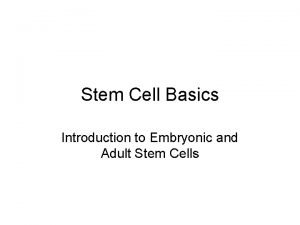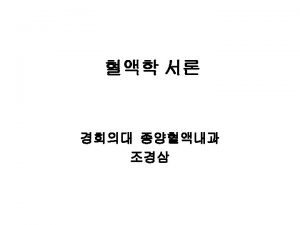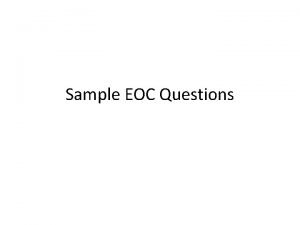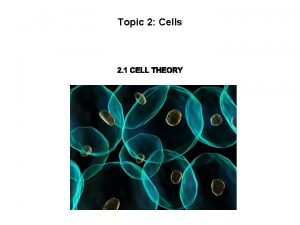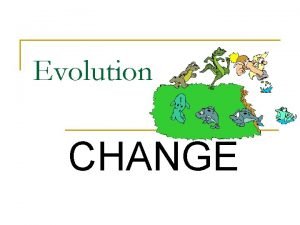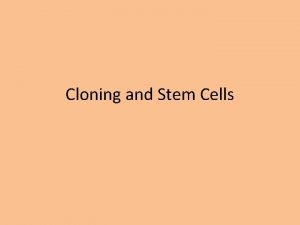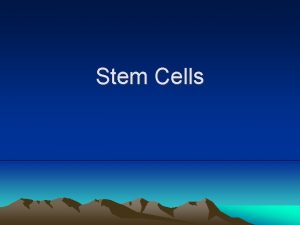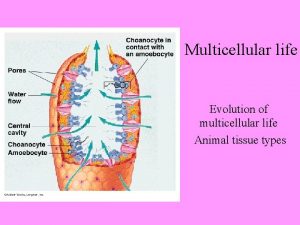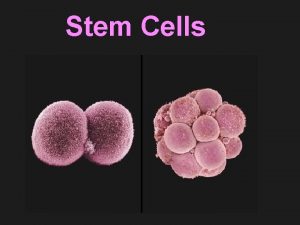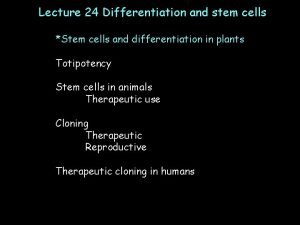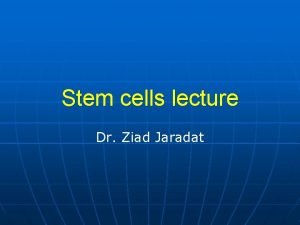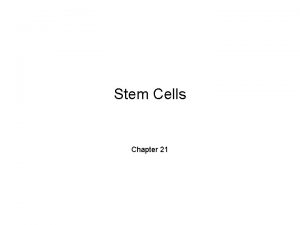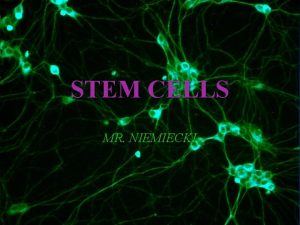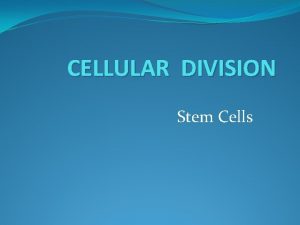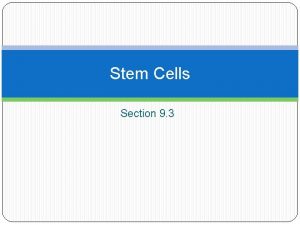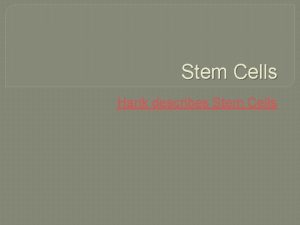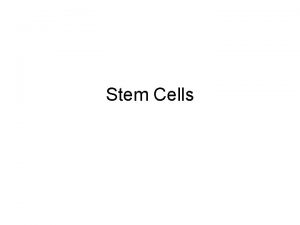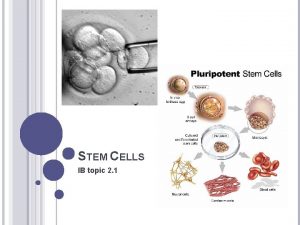Stem Cells Essential idea The evolution of multicellular
















- Slides: 16

Stem Cells Essential idea: The evolution of multicellular organisms allowed cell specialization and cell replacement. The background image shows totipotent stem cells. These unspecialised cell will be divide and some will become the cells that form heart muscle, neurones in the brain and lymphocytes in the blood. These three types of specialised human cells are structurally very different and perform certain functions much more efficiently than an unspecialised cell, such as the embryonic cells above, could. Another advantage that multicellular organisms have over unicellular organisms is that severe damage to a cell does not mean the end of an organism. Stem cell persist through the life of a multi-cellular organism, this enables organisms to digest severely damaged cells and replace them, i. e. wounds can be healed. www. ibdpbiohl. weebly. com

1. 1. U 4 Multicellular organisms have properties that emerge from the interaction of their cellular components. Emergent properties arise from the interaction of component parts. The whole is greater than the sum of its parts. Multicellular organisms are capable of completing functions that individual cells could not undertake this is due to the interaction between cells producing new functions.

1. 1. U 4 Multicellular organisms have properties that emerge from the interaction of their cellular components. Science traditionally has been taken a reductionist approach to solving problems and developing theories. Systems Biology uses inductive thinking as it is realised the importance of emergent properties, whether it be the interaction of genes, enzymes working together in a metabolic pathway, or cells forming tissues, different tissues forming organs, in turn forming organ systems and then the organism itself. At each level emergent properties arise.

1. 1. U 6 Differentiation involves the expression of some genes and not others in a cell’s genome. • All (diploid) cells of an individual organisms share an identical genome each cell contains the entire set of genetic instructions for that organism • BUT not all genes are expressed (activated) in all cells • In (totipotent) embryonic stem cells the entire genome is active • Newly formed cells receive signals which deactivate (or more rarely activate) genes, e. g. a skin cell does not need to be able to produce haemoglobin (the pigment in red blood cells that carries oxygen) Screenshot from this excellent tutorial: http: //www. ns. umich. edu/stemcells/022706_Intro. html

1. 1. U 5 Specialized tissues can develop by cell differentiation in multicellular organisms. • In humans 220 distinct highly specialised cell types have been recognised • All specialised cells and the organs constructed from them have developed as a result of differentiation Source: http: //images. wisegeek. com/types-of-human-cells. jpg

1. 1. U 7 The capacity of stem cells to divide and differentiate along different pathways is necessary in embryonic development and also makes stem cells suitable for therapeutic uses. Stem cells are unspecialised cells that can: • Can continuously divide and replicate • Have the capacity to differentiate into specialised cell types Totipotent Can differentiate into any type of cell. Pluripotent Can differentiate into many types of cell. Multipotent Can differentiate into a few closely-related types of cell. Unipotent Can regenerate but can only differentiate into their associated cell type (e. g. liver stem cells can only make liver cells). Image from: http: //en. wikipedia. org/wiki/Stem_cell

1. 1. U 7 The capacity of stem cells to divide and differentiate along different pathways is necessary in embryonic development and also makes stem cells suitable for therapeutic uses. Learn about stem cells using the tutorials http: //ns. umich. edu/stemcells/022706_Intro. html http: //learn. genetics. utah. edu/content/stemcells/scintro/ A Stem Cell Story http: //www. youtube. com/watch? v=2 -3 J 6 JGN-_Y

1. 1. U 7 Use of stem cells to treat Stargardt’s disease and one other named condition. Stargardt's macular dystrophy The problem • Affects around one in 10, 000 children • Recessive genetic (inherited) condition • The mutation causes an active transport protein on photoreceptor cells to malfunction • The photoreceptor cells degenerate • the production of a dysfunctional protein that cannot perform energy transport • that causes progressive, and eventually total, loss of central vision The treatment • Embryonic stem cells are treated to divide and differntiate to become retinal cells • The retinal cells are injected into the retina • The retinal cells attach to the retina and become functional • Central vision improves as a result of more functional retinal cells The future • This treatment is still in at the stage of limited clinical trials, but will likely be in usage in the future

1. 1. U 7 Use of stem cells to treat Stargardt’s disease and one other named condition. Learn about stem cell therapies using the tutorials http: //media. hhmi. org/biointeractive/click/Stem_Cell_Therapies/01. html

1. 1. U 7 Use of stem cells to treat Stargardt’s disease and one other named condition. Leukemia The problem • Cancer of the blood or bone marrow, resulting in abnormally high levels of poorly-functioning white blood cells. The • Hematopoietic Stem Cells (HSCs) are harvested from bone treatment marrow, peripheral blood or umbilical cord blood • Chemotherapy and radiotherapy used to destroy the diseased white blood cells • New white blood cells need to be replaced with healthy cells. • HSCs are transplanted back into the bone marrow • HSCs differentiate to form new healthy white blood cells The benefit • The use of a patient’s own HSCs means there is far less risk of immune rejection than with a traditional bone marrow transplant.

1. 1. A 4 Ethics of therapeutic use of stem cells from specially created embryos, from the umbilical cord blood of a new-born baby and from an adult’s own tissues. Comparison of stem cell sources Embryo Cord blood Adult Ease of extraction Can be obtained from excess embryos generated by IVF programs. Easily obtained and stored. Though limited quantities available Difficult to obtain as there are very few and are buried deep in tissues Ethics of the extraction Can only be obtained Umbilical cord is Adult patient can by destruction of an removed at birth give permission for embryo and discarded cells to be extracted whether or not stem cells are harvested Growth potential Almost unlimited Reduced potential (compared to embryonic cells) Tumor risk Higher risk of development Lower risk of development

1. 1. A 4 Ethics of therapeutic use of stem cells from specially created embryos, from the umbilical cord blood of a new-born baby and from an adult’s own tissues. Comparison of stem cell sources Differentiation Genetic damage Compatibility Embryo Cord blood Adult Can differentiate into any cell type Limited capacity to differentiate (without inducement only naturally divide into blood cells) Limited capacity to differentiate (dependent on the source tissue) Less chance of genetic damage than adult cells Stem cells are not genetically identical to the patient Due to accumulation of mutations through the life of the adult genetic damage can occur Fully compatible with the patient as the stem cells are genetically identical

1. 1. A 4 Ethics of therapeutic use of stem cells from specially created embryos, from the umbilical cord blood of a new-born baby and from an adult’s own tissues. Arguments for Therapeutic Cloning • Stem cell research may pave the way for future discoveries and beneficial technologies that would not have occurred if their use had been banned • May be used to cure serious diseases or disabilities with cell therapy (replacing bad cells with good ones) • Transplants are less likely to be rejected as they are cells which are genetically identical to the parent • Transplants do not require the death of another human • Stem cells can be taken from embryos that have stopped developing and would have died anyway (e. g. abortions) • Cells are taken at a stage when the embryo has no nervous system and can arguably feel no pain • Stem cells can be created without the need for fertilisation and destruction of ‘natural’ human embryos – induced pluripotent stem cells

1. 1. A 4 Ethics of therapeutic use of stem cells from specially created embryos, from the umbilical cord blood of a new-born baby and from an adult’s own tissues. Arguments Against Therapeutic Cloning • Involves the creation and destruction of human embryos (at what point do we afford the right to life? ) • Embryonic stem cells are capable of continued division and may develop into cancerous cells and cause tumors • More embryos are generally produced than are needed, so excess embryos are killed • With additional cost and effort, alternative technologies may fulfill similar roles (e. g. nuclear reprogramming of differentiated cell lines) • Religious or moral objections due to the ‘playing God’ argument. • The embryo which is created could potentially be used in IVF and develop into a human fetus, so are we creating human life to destroy it? • Although cloning humans reproductively is illegal, this has not been ratified by all nations. Potential for a race to clone the first human.

1. 1. A 4 Ethics of therapeutic use of stem cells from specially created embryos, from the umbilical cord blood of a new-born baby and from an adult’s own tissues.

1. 1. A 4 Ethics of therapeutic use of stem cells from specially created embryos, from the umbilical cord blood of a new-born baby and from an adult’s own tissues. Check out the news – there are new stories on i. PS all the time
 17-3 evolution of multicellular life
17-3 evolution of multicellular life Section 17-3 evolution of multicellular life answer key
Section 17-3 evolution of multicellular life answer key Essential non essential fatty acids
Essential non essential fatty acids Where can scientists obtain stem cells? *
Where can scientists obtain stem cells? * Pluripotent stem cells examples
Pluripotent stem cells examples Stem cells
Stem cells Conclusion of stem cells
Conclusion of stem cells Cellpast
Cellpast Precursor cells
Precursor cells Stem cell classification chart
Stem cell classification chart Which statement best describes embryonic stem cells?
Which statement best describes embryonic stem cells? Outline one therapeutic use of stem cells
Outline one therapeutic use of stem cells Stem cells webquest
Stem cells webquest Stem cells specialization
Stem cells specialization Stabilizing selection
Stabilizing selection Paranasal sinus at birth
Paranasal sinus at birth Tubular reabsorption
Tubular reabsorption

